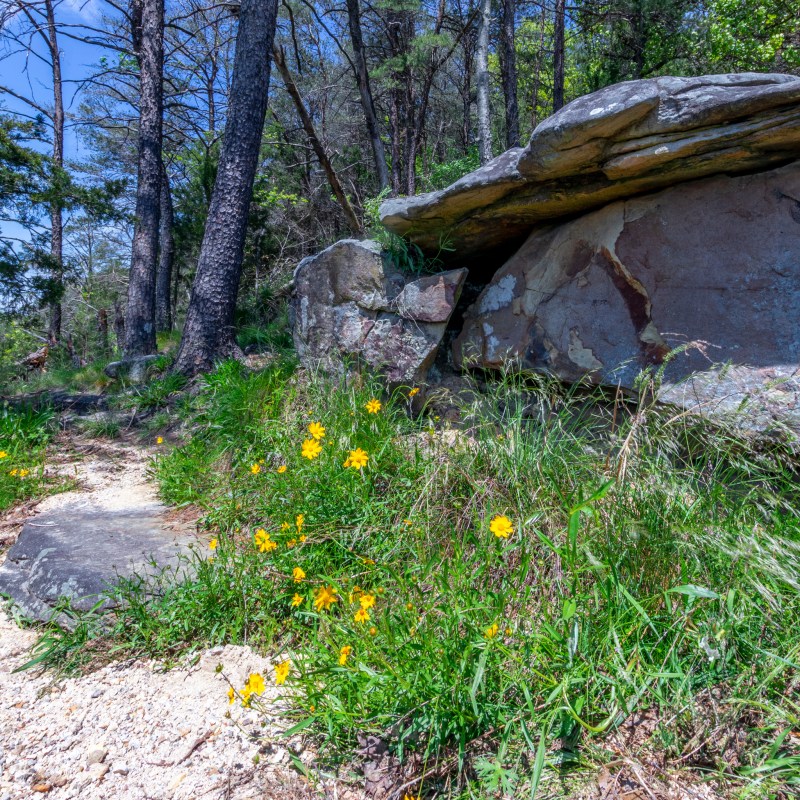
There is something soothing about hiking through a forest and becoming enveloped with the sweet fragrance and eye-stimulating beauty of wildflowers. It’s what makes an ordinary walk in the woods magical.
Videos by TravelAwaits
There are many — and I mean many — hiking trails in Alabama inviting you to experience their colorful world. Here are seven of the state’s best trails to explore for rainbows of wildflower color.
Unless otherwise noted, the best time to view the rainbow of colors is from early spring to late summer.

1. Cane Creek Canyon Nature Preserve
Tuscumbia
Incredible rock shelters, waterfalls, crystal clear creeks and streams, and brilliant wildflowers can be found all in one Alabama preserve — Cane Creek Canyon Nature Preserve in Tuscumbia.
Jim and Faye Lacefield have been acquiring the acres of land that encompass the canyon for years, opening it — and a multitude of trails — to the public. Today, the preserve totals over 700 acres and is jointly managed by The Nature Conservancy and Alabama’s Forever Wild program.
From early spring through late summer, the canyon is rimmed with beautiful wildflowers, including yellow lady’s slippers, azalea, and the rare French’s shooting star with its delicate cluster of backward-pointing rose-, white-, or lilac-colored leaves. The trails also lead you to a lush wildflower glade and house-sized boulders topped with natural flower gardens.
Pro Tips
Jim and Faye still live at Cane Creek. In fact, you will park near their home. The preserve is open from 7 a.m. to 5 p.m. You are required to sign in when you arrive and sign out when leaving, but admission is free. There are well over 15 miles of trail to explore, and for the most part, they are moderate in difficulty. Just remember that what goes down, must come up. It is a canyon, and you have a steady climb back out.

2. Wildflower Trail
Huntsville
Your hike along the aptly named Wildflower Trail at the Monte Sano Nature Preserve in Huntsville is brimming with color spring through fall. Along the half-mile trail, hikers will be treated to brilliant yellow trout lily, white shooting star, the sweet and fruity fragrance of sweet Betsy trillium, and the five blue, pink, or purple leaves of wild blue phlox.
The path parallels Fagan Creek, which, after a good rain, really begins to flow. It has a soothing, wide waterfall.
Pro Tips
The trailhead is located on Cleermont Drive. It is a small parking lot, so be sure to arrive early. The preserve is open from sunrise to sunset. The half-mile (one-way) hike is relatively easy to walk. The Land Trust of North Alabama (LTNA) manages the property and hosts an online guide to the wildflowers found along the trail that can be accessed here. LTNA also hosts numerous guided hikes, including wildflower hikes; visit their website for schedules.

3. Tom Bevill Trail
Albertville
A much-overlooked trail at Lake Guntersville State Park is the 3.8-mile Tom Bevill Trail. The trail loops around the top of Ellenburg Mountain where an old homestead once stood in the town of Guntersville.
The hike is a beautiful walk in the woods with a thick canopy to shade you in the hot summer months. Picturesque views and cool breezes from the lake greet you as the trail heads to the north, and all the while, a rainbow of colorful wildflowers leads the way — fragrant flowering pink and white dogwoods, flaming red cardinal flowers, black-eyed Susans, and purple phlox.
Pro Tips
The trailhead for this hike is located on Alabama Highway 227 in the town of Albertville. There is no day-use fee from this trailhead, and the park is open from sunrise to sunset. The trail begins across the road, so use caution crossing. While the 3.4-mile loop around the mountain is an easy walk, the 0.4-mile climb up to the loop is a difficult and steep climb.

4. George W. Folkerts Bog Trail
Bay Minette
The Nature Conservancy’s Ruth McClellan Abronski Splinter Hill Bog Preserve (or just Splinter Hill Bog) is described as the most visually impressive pitcher plant bog in the world, and when you are standing among literally thousands of the carnivorous plants, that’s a claim that’s hard to argue.
Pitcher plants are much like Venus flytraps. Their long, green, tubular stem is covered by a small flap. At the bottom of the tube is a sweet nectar that attracts insects. Once the bugs go in, they never come out.
Despite this gruesome description, the white-top plants are a spectacular sight that blooms from early April to early July. And you don’t have to hike far to see them. The actual spectacle is only a few short yards from the trailhead. It is an easy walk and is ADA accessible.
But there is more to see at Splinter Hill Bog. An easy (but not ADA accessible) trail — the George W. Folkerts Bog Trail — is a 3.1-mile out-and-back walk along an old dirt road where sundews, butterworts, milkworts, and orchids line the sun-drenched path.
Pro Tips
The trailhead is located on Baldwin County Road 47 in Bay Minette, Alabama. Remember, the trail here does wind through a bog. Be sure to slather on the insect repellant when you visit. Admission is free.

5. Mountain Laurel Trail
Delta
A twofer hike is in store for you high atop Alabama’s tallest mountain at Cheaha State Park. On the Mountain Laurel Trail, you’ll hike through tunnels of beautiful, flowering mountain laurel and behold the most breathtaking views of the Talladega mountains from the Rock Garden.
The moderately difficult, 1.4-mile (one-way) hike takes you through the lanes of mountain laurel, following the banks of a stream. The stream fills a stone reservoir, built by the Civilian Conservation Corps in the 1930s, with a sparkling cascade tumbling down its spillway before taking you to the Rock Garden.
Pro Tips
Begin your hike at the trailhead near the park’s chalets. Most of the hike is a moderate but rocky trek, but use caution visiting the Rock Garden. It’s a precipitous drop. The park opens at 7 a.m., and the trails close at sunset. There is a nominal day-use admission fee for adults, with reduced rates for children and seniors. It’s free for kids under four, veterans, and active-duty military.

6. Talmadge Butler Boardwalk Trail
Fort Payne
The sweet smell of mountain honeysuckle, the beautiful inward-rolled rose petals of Catesby’s trillium, and the gorgeous pink flowers of climbing wild geraniums are only a few of the many wildflowers that grace the Talmadge Butler Boardwalk Trail at DeSoto State Park.
The Talmadge Butler Boardwalk is ADA accessible. It is 400-yards long and leads to the soothing waters of Azalea Cascade, a beautiful waterfall that is framed with fiery red azaleas spring through summer.
For those with special needs or small children, you can turn around at the falls and return to your car, otherwise, continue past the boardwalk on the red-blazed Azalea Cascades Trail. This is a moderate hike through the woods that heads up a hill to the fun and fascinating Needle Eye Rock, where you walk between the cuts in the rock.
Pro Tips
DeSoto State Park is open from sunrise to sunset. The trailhead is located on DeSoto Parkway Northeast in Fort Payne, just north of the park’s country store. There is no day-use fee charged. While the boardwalk portion of the hike is easy and ADA accessible, the remainder of the hike is moderate in difficulty with plenty of rocks and roots, but the reward is worth the effort. Again, visit the park’s website or country store for information on scheduled spring wildflower hikes.

7. Rhododendron Trail
Fort Payne
The wildflowers on this half-mile, out-and-back hike high above the rushing waters of the West Fork of Little River are intoxicating.
Begin this hike at the DeSoto State Park swimming pool and take the aquamarine-blazed Pool Loop Trail until it meets the yellow-blazed DeSoto Scout Trail. Follow the yellow blazes and view the white-water river below as you walk through stands of Catawba rhododendron, bluets, yellow star grass, and wild camellia. Your turn around for this hike is the crashing waters of Indian Falls.
Pro Tips
The trailhead is located at the park’s swimming pool parking area. The trail itself is moderate in difficulty with plenty of rocks and roots, but the reward is worth the effort.
Related Reading:
